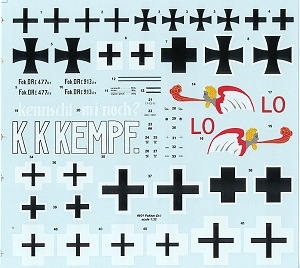
| KIT: | Roden 1/32 Fokker Dr.I |
| KIT #: | 601 |
| PRICE: | $35.98 (32.46 at Squadron) |
| DECALS: | Four options |
| REVIEWER: | Scott Van Aken |
| NOTES: |

| HISTORY |
Thanks to www.rodenplant.com for the historical background.
| THE KIT |
 It
is with much anticipation that the modeling world has awaited a quality
1/32 Fokker Dr.I. It seems as if these large scale models are the coming
thing. Why? Well it is a simple matter of desire from the buying public and
the simple fact that in many respects, the types of aircraft kits that sell
well have already been done in 1/72 and 1/48.You can postulate that the
worsening eyesight of their target market, baby boomers, might have
something to do with it, but that is not true as when you do larger kits,
you need to add in all that detail that wasn't done in smaller scales.
Hence a preponderance of tiny pieces.
It
is with much anticipation that the modeling world has awaited a quality
1/32 Fokker Dr.I. It seems as if these large scale models are the coming
thing. Why? Well it is a simple matter of desire from the buying public and
the simple fact that in many respects, the types of aircraft kits that sell
well have already been done in 1/72 and 1/48.You can postulate that the
worsening eyesight of their target market, baby boomers, might have
something to do with it, but that is not true as when you do larger kits,
you need to add in all that detail that wasn't done in smaller scales.
Hence a preponderance of tiny pieces.
If you have had the pleasure of building a more recent Roden kit, then this one is very much similar. The parts are very well molded, the 'hills and valleys' of the fabric surfaces have been kept to a minimum. No sink areas (that I could initially find), and the few ejector pin marks will be invisible once the model is complete. There is a tad of flash on some of the thinner parts like the interior frame work. In fact, cleaning up all the detail bits will probably be one of the more time-consuming facets of building this kit.
Detail is very nicely done with some
rather finely molded parts like the interior framework, Rudder pedals and
control stick, machine guns and the engine. The engine itself is built of
two halves with separate manifold and individual valve covers for each
cylinder. Ailerons are separate pieces and each of the wings has a separate
end cap. Some folks like that and some do not. I'm ambivalent about it as I
have little trouble filling in wing tip seams. There are some parts that
are not used in this boxing. One is the narrower horizontal stabs and
elevators. There are also additional ailerons, while another is a different prop and
finally, a set of machine guns that have no cooling jacket. This is for
those of you who have etched cooling jackets that you might want to use. Though the Dr.I was not
that widely used and lasted in front line service only a short time, it was
used by a number of Jastas and so there are a wide variety of colors that
could be used.
Instructions are the exceptional product that we have come to expect from Roden. 15 construction steps that clearly show where parts go as well as providing color information (Humbrol and generic references). No rigging diagram is given, but due to the limited amount of rigging (one of the attractions of this kit), you can glean that information from the box art. A huge decal sheet accompanies the kit with the following markings options:
Don't be thinking it is a small sheet as it nearly covered the platen on my scanner. The quality is excellent and the decals are quite glossy. I'm hoping that these work well, though I'm equally sure that there will be aftermarket sheets for this kit out soon. One thing for sure, you'll need to brush up on your paint work as the Dr.I often carried a streaky olive paint scheme that only looks good when hand painted.
| CONCLUSIONS |
I can tell you that this kit is already on the work bench and I'm finding the fit to be a real delight. After the frustration of a certain French D.VIII (which is on the crawl-track to completion), this one will be a pleasure to build. Look for the full build review in a few weeks.
You can find this kit and many others at

If you would like your product reviewed fairly and fairly quickly by a site that has around 300,000 visitors a month, please contact me or see other details in the Note to Contributors.